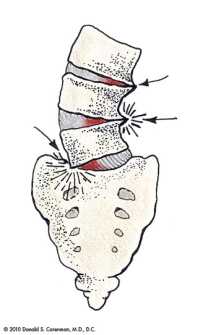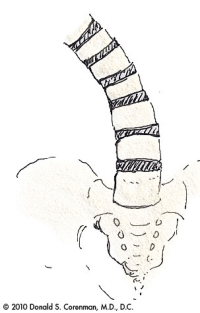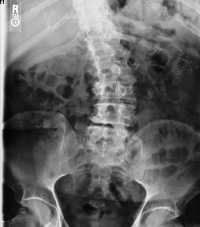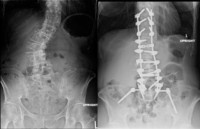Overview
Normal spinal alignment and balance are very important to energy consumption with standing and walking. Scoliosis is an abnormal curvature of the spine. A curve in the front to back plane (coronal plane) of greater than 10 degrees is called a scoliosis. If the curve is less than 10 degrees, it is not considered scoliosis. Normally, degenerative scoliosis of the lumbar spine should not be painful until the degenerative process advances and causes local problems. The only time the actual non-symptomatic curve needs to be addressed in a mature individual is when the curve becomes significantly larger or the patient is out of balance when standing. Children with scoliosis or a similar spine deformity are a different story. The curvature of the spine can silently advance in a child and treatment for scoliosis is commonly necessary.
In the adult, skeletal disorders such as scoliosis lead to accelerated degenerative changes of the discs and vertebra, causing spine pain and other symptoms. The load on the spinal column is concentrated on a small portion of the total available surface area of the disc and facet. This increased pressure will wear out the segments faster than an evenly loaded spine. A comparison is a car tire knocked out of alignment. Normally, unless you drive like me, you can expect 20-30,000 miles out of a set of tires. However, the if camber is off, the tire will wear in less than 5,000 miles as the pressure is increased only on one side of the total potential contact area.
Symptoms of
Degenerative scoliosis of the lumbar spine, as well as any other curvature of the spine deformity of the lumbar spine, can cause most of the symptoms of any of the single disorders listed in the low back category such as herniated disc or spinal stenosis. In addition, low back pain and spine pain are common complaints as when the discs wear out and start to subluxate (lateral lysthesis or bone on bone pain).
Are you suffering from symptoms of degenerative scoliosis of the lumbar spine?
Would you like to consult with Dr. Corenman about your condition?
You can set up a long distance consultation to discuss your
current X-rays and/or MRIs for a clinical case review.
(Please keep reading below for more information on this condition.)
Treatment of
Non-Surgical
Treatment for most skeletal disorders, including degenerative scoliosis of the lumbar spine, usually begins with conservative measures. There are standard treatments such as with medications, physical therapy and spinal injections. These also help with the spine pain that may result from the spine deformity. Some individuals gain benefit from traction or antigravity machines. Impact activities need to be restrained. Chiropractic can be helpful but mobilization of the segments may increase the abnormal curve of the back.
Surgical
Surgery for scoliosis will be considered after conservative measures have failed. If surgery for a curvature of the spine is necessary, surgical treatment may only need to involve the localized individual painful problem such as a herniated disc or a degenerative spondylolysthesis with stenosis. There are occasions that a degenerative scoliosis can be like a house of cards and a simple operation can destabilize the spine. A more involved surgery for scoliosis may be necessary and the experience of the surgeon in these matters can be quite helpful.
If you live in the Vail, Aspen, Denver and Grand Junction, Colorado area and are experiencing symptoms associated with
Related Content
- When to Have Lower Back Surgery
- Causes of Lower Back Pain
- Normal Spinal Alignment
- How to Describe Your History and Symptoms of Lower Back and Leg Pain
- Best Questions to Ask When Interviewing a Spine Surgeon or Neurosurgeon
- Degenerative Spondylolisthesis
- Scoliosis Surgery
- Isolated Disc Resorption-Lumbar Spine (IDR)
- Lumbar Spinal Stenosis (Central Stenosis)

(Click to Enlarge Image) This diagram shows the angular collapse that can occur with asymmetric wear of the spine. The foramen that the nerve exits from is substantially narrowed by this collapse and nerve pain can occur with walking.



